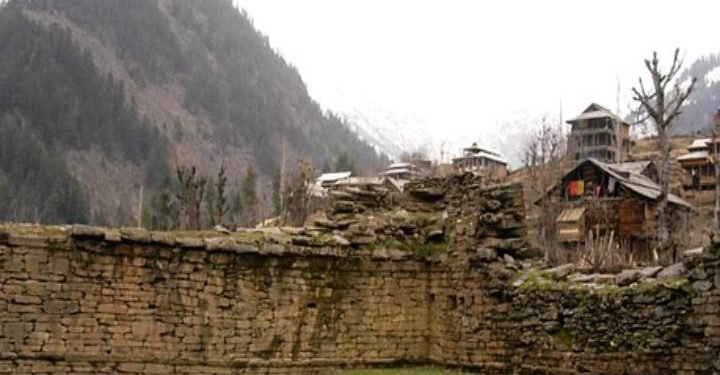Saraswathi was the famous temple of goddess Sharada in Kashmir – also called Kashyappur named after Rishi Kashyap – on the banks of Neelum Kishenganga river . Its ruins are now in the Neelum District of Azad Kashmir, Pakistan near the Line of Control. Kashmir was sometimes called Sharada Desh because of this temple.
Shrine’s History
In a poetic work composed by Mahakavi Kalhana in the year 1148 CE, there is a mention of Sree Sharadad Devi temple and its geographic location. Kalhana mentions that in Lalitaditya’s reign , some followers of a king of Gauda , come to Kashmir under the pretence of visiting the shrine of Śāradā.The first verse of ‘Prapanchsar’ composed by Adi Shankaracharya is devoted to the praise of Sree Sharada Devi. In the year 1030 CE, the Muslim historian Al-Baruni visited Kashmir. According to him, there was a wooden idol of Sree Sharada Devi in Sree Sharada Devi temple. He compared the temple of Sree Sharada Devi with the Multan Sun Temple, Vishnu Chakraswamin temple at Thaneshwar and Somnath temple. During 16th century, when Akbar was ruling at Delhi, Abul Fazal, one of the famous ‘Nava-Ratnas’ in his Court, has written about Sree Sharada Devi temple that Sree Sharada Devi temple is near the banks of river Madhumati which is full of gold particles and he also wrote that one can experience miracles on every eighth day of the bright fortnight of the month. In the 14th century, the temple was attacked for the first time. After this attack, India started losing its contact with Krishanganga and Sharada Peeth. In the 19th century, Dogra king of Kashmir restored this temple.
In 1948, during raids by Pakistani tribal raiders, the village fell into Pakistani hands. A famous learning centre of Kashmiris, it is identified by noted historians and chroniclers including Al Beruni as one of the most important temples of the Hindus equivalent to the Shiva Lingam of Somnath, Vishnu of Thaneshwar and Surya of Multan. Abul Fazl in Ain-i-Akbari says that on every eighth day of the month at the time of full moon, the temple “shakes and produces the most extraordinary effect.” He, however, does not explain the “extraordinary effect. ” The temple is so vital to Kashmiris that the Kashmiri language has the script of Sharda, which is little similar to Devanagari. Kalhana in Rajatarangini has said, devotees of Durga and Shiva from all over the country would flock to the temple of Sharda which can be approached from Bandipur in North Kashmir, about 80 km from Srinagar. Through centuries the temple had remained the object of worship and devotion of lakhs of pilgrims from all over the country. Though in ruins now, the entire temple complex inspires grandeur and awe.

Legends Associated with This Shrine
There are four gates in four directions for entering Sharada Nilaya. Eminent scholars and philosophers had entered it from various directions and had established their scholarly merit But no one so far had adorned this chair of Sarvajna. And also till their no one had even attempted to enter the temple through the Southern gate Maybe this gate was waiting for Acharya Shankara. only who was from the South Scholars of many group and communities were waiting for him in the premises of Sir Sharada Nilaya All were filled with a feeling of reverence to see him who was learned in both Jnana and Vijnana Yet the scholars in religious philosophies of Jaina, Buddha, Samkhya, Yoga, Nays and Vaisheshika confronted him at the time of his entry to the temple, Shankara defeated all of them in philosophical debate and then entered the temple through the Southern gate. Acharya went to ascend Sarvajna Peetha. Sri Sharada, the presiding deity of all learning, herself set a test for him. Shankara passed this test also. After this the Goddess Herself blessed him, proclaiming his omniscience. So say the Shankara Vijaya.
Architectural Relevance of This Shrine
The temple is so ancient that Kashmir State was earlier known as ‘Sharada Peeth’. It is at this temple that Sankaracharya received the right to sit on the Sarvanjnanapeetham or Sarvajna peetha.The temple is at a height of 11000 feet above the sea level and is about 70 miles from Srinagar, summer Capital of Indian Administered Kashmir. The length of the temple is 142 feet and width is 94.6 feet. The outer walls of the temple are 6 ft. wide and 11 ft long. And there are arches with 8 ft. height. It is a very good example of architecture. The Śāradā image at Shringeri Sharadamba temple was once said to have been made of sandalwood, which is supposed to have been taken by Sankaracharya from here.
Shrine’s Map Location and How to Go There
By Road
The temple is located in the remote village of Sharda, in Pakistan’ Neelam Valley, at a distance of 60 miles from Baramulla in Indian-administered Kashmir, and 40 miles from Muzaffarabad, capital of Azad Kashmir. It lies 16 miles to the northwest of the Line of Control in a militarily sensitive area. Given its close proximity to the contentious Line of Control, access to the site by foreigners is sometimes restricted during periods of heightened tension with India
By Rail
Baramulla does not have an train station. Nearest option is Srinagar Kashmir..
By Air
Nearest airport is Srinagar Airport
Extra Information About this Shrine
In 2007, a group of Kashmiri Pandits who were permitted to visit Aziz Kashmir were denied permission visit the temple. Citizens of Pakistan, including its Hindu population, do not face any official restriction in visiting the site. Visitors from India are generally refused access to the region, given its close proximity to the Line of Control, though foreigners from other countries do not face similar restrictions – although they may be denied entry during periods of heightened tensions with India.













































